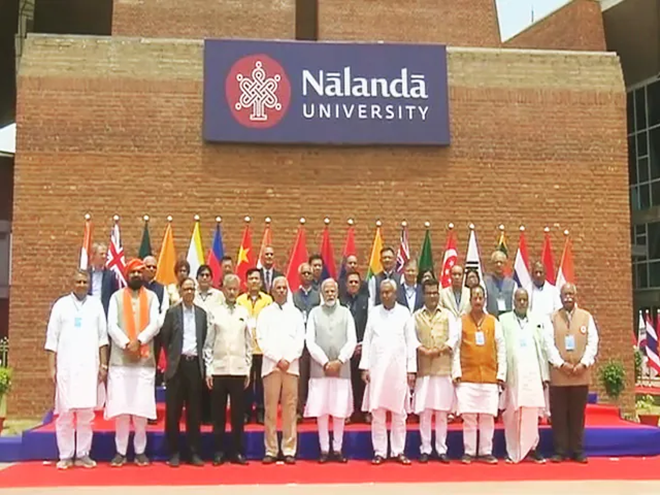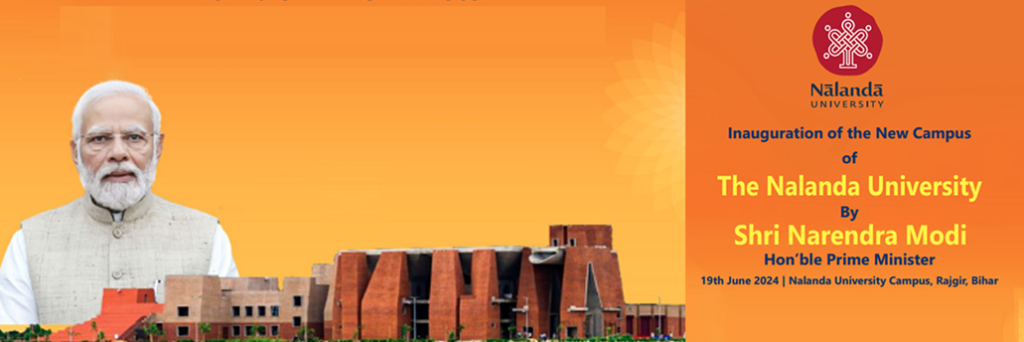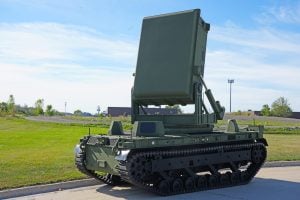Prime Minister Narendra Modi, inaugurated the new campus of Nalanda University in Rajgir, Bihar. The event was also attended by Governor Rajendra V Arlekar, Chief Minister Nitish Kumar, and External Affairs Minister S Jaishankar. During the inauguration of the new Nalanda University campus, Modi urged students to maintain their curiosity and courage.
A New Dawn For Nalanda University
Why In News
- Prime Minister Narendra Modi, inaugurated the new campus of Nalanda University in Rajgir, Bihar. The event was also attended by Governor Rajendra V Arlekar, Chief Minister Nitish Kumar, and External Affairs Minister S Jaishankar. During the inauguration of the new Nalanda University campus, Modi urged students to maintain their curiosity and courage.
- He described Nalanda as a symbol of India’s rich academic heritage and dynamic cultural exchange. ” It is not just a renaissance of India’s past, but the heritage of many countries are linked to this place.
Nalanda University
- Centuries ago, Nalanda was a center of knowledge for the entire northern region of present-day India. Founded Kumargupta founded Nalanda University in the 5th century A.D. He was also called Shakraditya.
- It flourished for 800 years before invaders destroyed it in the 12th century. Stalwarts such as Nagarjuna, Diganaga and Asanga resided and taught at Nalanda University and Shisksha Sammucchchyaya by Shantideva, a compendium on learning was written here.
- “The emergence of ŚrīNālandāMahāvihāra and its new organised instructive practices marked the beginning of a new era in South Asian education. It symbolised the height of the ancient Indian educational syste
- The transformation of mahāvihāras into learning and training institutions was the beginning of institutionalized instruction in South Asia, which was itself different from gurukulas.”
- The Buddhist sources tell us that it was King Sakaraditya (Kumara Gupta I) who laid the foundations of the Nalanda University in the middle of the 5th century AD.
- While the West has historically found it difficult to accommodate divergent religious and cultural inspiration, it is remarkable that the ancient Gupta rulers could extend significant patronage to what began as a Buddhist centre of learning, while being devoted to Hindu Vaishnava religious ideas and practices.
- Nalanda University was destroyed three times by different invaders. The first destruction was caused by the Huns under the reign of Mihirakula. The second destruction came during the 7th century by the Goudas.
- This time, the Buddhist king Harshavardhana then restored the university. In 1193 AD, the army of Turkish ruler Qutb-ud-din Aibak’s general Bakhtiyar Khilji attacked this university, looted its building, and set it on fire. Despite this, the vast ruins of Nalanda University continued to testify to its greatness.
- The new campus is near the ancient ruins of Nalanda, a university established by the Nalanda University Act of 2010. The Act implemented a decision to establish the university made at the second East Asia Summit held in the Philippines in 2007.
- The contemporary university commenced its operations in 2014 at a provisional site with an initial cohort of 14 students, and construction began in 2017.
- Besides India, a total of 17 countries have signed MoUs to support the Nalanda University. These nations include Brunei Darussalam, Cambodia, New Zealand, Portugal, Australia, Bangladesh, Bhutan, Singapore, South Korea, Indonesia, Laos, Mauritius, Sri Lanka, Thailand, China, Myanmar, and Vietnam.
- It comprises six schools: the School of Buddhist Studies, Philosophy & Comparative Religions, Historical Studies, Ecology and Environmental Studies, and Sustainable Development and Management.
- International students enrolled in the Postgraduate programs for the academic years 2022-24, 2023-25, and the PhD program for 2023-27 come from a diverse array of countries, including Argentina, Bangladesh, Bhutan, Cambodia, Ghana, Indonesia, Kenya, Laos, Liberia, Myanmar, Mozambique, Nepal, Nigeria, Republic of Congo, South Sudan, Sri Lanka, Serbia, Sierra Leone, Thailand, Turkey, Uganda, USA, Vietnam, and Zimbabwe.
- The campus has two academic blocks containing 40 classrooms, with a combined seating capacity of approximately 1,900. Two auditoriums, each accommodating 300 seats, are also on campus. The student hostel can house around 550 students. Additionally, the campus offers various facilities, including an international centre, an amphitheatre with a capacity for 2,000 people, a faculty club, and a sports complex.
- The campus is a ‘Net Zero’ Green Campus, designed to be self-sustaining with solar power installations, domestic and drinking water treatment facilities, a water recycling plant for reusing wastewater, 100 acres of water bodies, and numerous other eco-friendly amenities.
- The university is envisioned as a partnership between India and the East Asia Summit (EAS) countries. It holds significant historical importance, as the original Nalanda University, founded approximately 1600 years ago, is regarded as one of the world’s first residential universities.

























